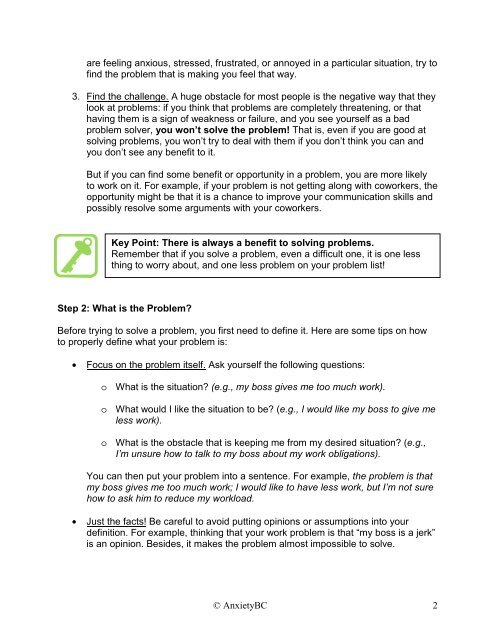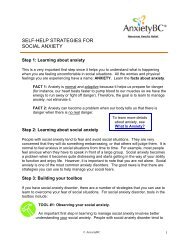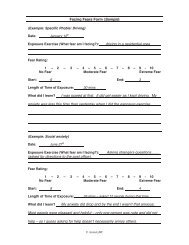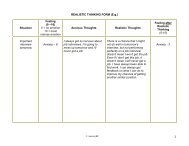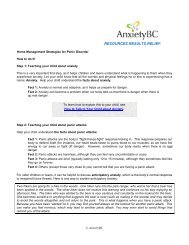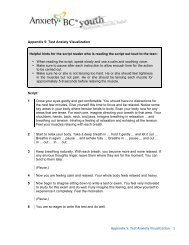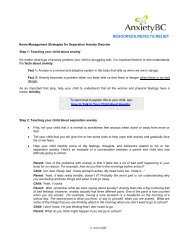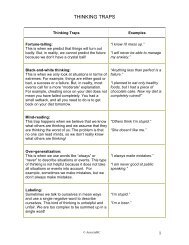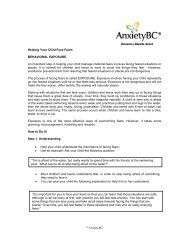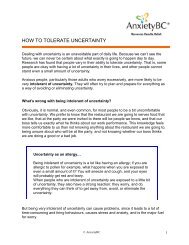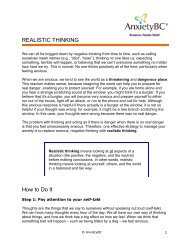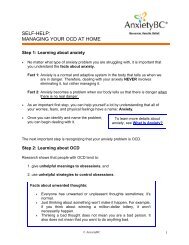How to Solve Daily Life Problems - AnxietyBC
How to Solve Daily Life Problems - AnxietyBC
How to Solve Daily Life Problems - AnxietyBC
Create successful ePaper yourself
Turn your PDF publications into a flip-book with our unique Google optimized e-Paper software.
are feeling anxious, stressed, frustrated, or annoyed in a particular situation, try <strong>to</strong><br />
find the problem that is making you feel that way.<br />
3. Find the challenge. A huge obstacle for most people is the negative way that they<br />
look at problems: if you think that problems are completely threatening, or that<br />
having them is a sign of weakness or failure, and you see yourself as a bad<br />
problem solver, you won’t solve the problem! That is, even if you are good at<br />
solving problems, you won’t try <strong>to</strong> deal with them if you don’t think you can and<br />
you don’t see any benefit <strong>to</strong> it.<br />
But if you can find some benefit or opportunity in a problem, you are more likely<br />
<strong>to</strong> work on it. For example, if your problem is not getting along with coworkers, the<br />
opportunity might be that it is a chance <strong>to</strong> improve your communication skills and<br />
possibly resolve some arguments with your coworkers.<br />
Key Point: There is always a benefit <strong>to</strong> solving problems.<br />
Remember that if you solve a problem, even a difficult one, it is one less<br />
thing <strong>to</strong> worry about, and one less problem on your problem list!<br />
Step 2: What is the Problem<br />
Before trying <strong>to</strong> solve a problem, you first need <strong>to</strong> define it. Here are some tips on how<br />
<strong>to</strong> properly define what your problem is:<br />
• Focus on the problem itself. Ask yourself the following questions:<br />
o What is the situation (e.g., my boss gives me <strong>to</strong>o much work).<br />
o What would I like the situation <strong>to</strong> be (e.g., I would like my boss <strong>to</strong> give me<br />
less work).<br />
o What is the obstacle that is keeping me from my desired situation (e.g.,<br />
I’m unsure how <strong>to</strong> talk <strong>to</strong> my boss about my work obligations).<br />
You can then put your problem in<strong>to</strong> a sentence. For example, the problem is that<br />
my boss gives me <strong>to</strong>o much work; I would like <strong>to</strong> have less work, but I’m not sure<br />
how <strong>to</strong> ask him <strong>to</strong> reduce my workload.<br />
• Just the facts! Be careful <strong>to</strong> avoid putting opinions or assumptions in<strong>to</strong> your<br />
definition. For example, thinking that your work problem is that “my boss is a jerk”<br />
is an opinion. Besides, it makes the problem almost impossible <strong>to</strong> solve.<br />
© <strong>AnxietyBC</strong> 2


